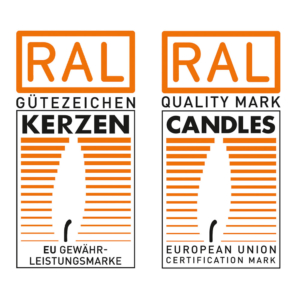quality-certified raw materials!
These specific quality assurance and test specifications apply to candles, regardless of the surface structure for product variants such as advent candles, altar candles, tree candles, birthday candles, household candles, votive candles, pyramid candles, miniature candles, taper candles, rod candles or pillar candles.
Within this scope, the above products need to meet the requirements of the Quality Mark for Candles.
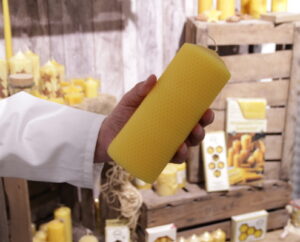
The wick must be centred. Exception: multi-wick candles.
The surface of the candle must be free of bubbles, cracks, chips and damage when viewed without technical aids. An exception to this rule is permitted only if these features are decorative in nature.
The candle has the required shade and intensity of colour.
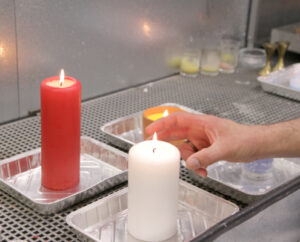
After lighting, the candle must show a luminous, steady flame and gradually form a rim that surrounds the burn pool.
After lighting, the candle must show a luminous, steady flame and gradually form a rim that surrounds the burn pool.
Also, the wick needs to be moderately curved as the candle burns down (see Section 1-3.3),
The candle must not drip (see Section 1-3.4) and
The flame must burn without producing visible soot (see Section 1-3.5).
For technical reasons, the assessment of burning properties with regard to compliance with these requirements can only be carried out on pillar candles with a diameter of 31 to 60 mm up to a residual height of 30 mm; on pillar candles with a diameter of more than 60 mm only up to a residual height of 40 mm, and on altar candles only up to a residual height of 80 mm.
After the flame has been extinguished, the tip of the wick normally continues to glow for some time. This is associated with some release of smoke. This process should be complete within 15 seconds in candles of up to 30 mm diameter. In the case of candles with a diameter of more than 30 mm, it is permissible for the flat wick to smoke for 20 seconds, but the wick must never completely burn up (this also applies to round wicks), such that it can be easily relit and the candle will continue to burn properly.
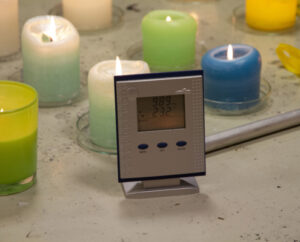
If the candle’s burning time is stated on the packaging, this must be achieved (see Section 1-3.6).
The temperature of the test room must be between 20°C and 25°C to test burning. The candles must be positioned vertically and far enough apart from each other to ensure that heat is not noticeably transferred from candle to candle. The exact clearances will depend on the candle format and the candles must be well protected from draughts.
Sample combustion of the test samples must be carried out in different burning cycles according to the size of the candle. Burning cycle 1 for tree candles, miniature candles, egg candles and other types of candle weighing up to 40 grams:
Burning cycle 1 for tree candles, miniature candles, egg candles and other types of candle weighing up to 40 grams:
Burning cycle 2 and 3 for candles weighing more than 40 grams and measuring up to 30 mm in diameter:
Burning cycle 4 and 5 for candles measuring 31 mm to 60 mm in diameter (changing from day to day):
Burning cycle 6 for candles larger than 60 mm in diameter:
The wick protrudes straight out of the candle and should then bend evenly to the outside edge of the flame during burning. The tip of the wick should burn gradually there, where the flame temperature is at its highest, until it is fully incinerated.
This means that slight curving of the wick as shown in figure 2 is ideal and curving of the wick as shown in figure 3 is still good.
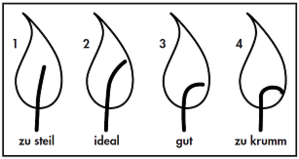
The behaviour of wick during burning is assessed visually.
| Wick curves as shown in figure 2 or 3 | requirement met |
| Wick deviates significantly from figure 2 or 3 | requirement not met |
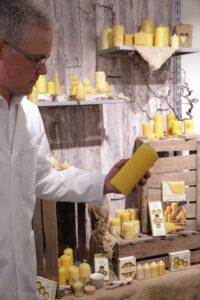
Dripping refers to the fuel flowing out of the candle’s burn pool. A candle is described as drip-resistant if this is prevented by the rim produced.
A small amount of wax flowing out is tolerable for candles measuring up to 30 mm under the following conditions:
When the candle is relit, the wick is able to reach its full capillary action (i.e. drawing melted wax to the flame) again only after a few minutes. Consequently, a few drops of wax may flow out temporarily during this phase. This phenomenon should not be seen as insufficient drip resistance. Drip resistance is assessed visually.
| Rim prevents wax flowing out | requirement met |
| Molten wax flows off the candle | requirement not met |
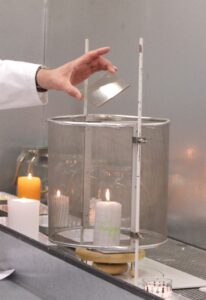
For chemical and physical reasons, it is not possible for a candle to burn without emitting any smoke at all, especially when burning starts and immediately after the flame goes out. Soot emission should, however, be minimised – primarily by using the optimum combination of candle material and wick—so that low-soot burning occurs.
a) Visual
| No visible soot emission | requirement met |
| Candle emits sooty smoke | requirement not met |
b) As described in the test procedure set out in Section 8 of EN 15426, the soot properties of candles (with the exception of ball candles, egg candles, candles with special shapes and candles with a diameter of more than 70 mm) must also be assessed according to the following criteria:
A soot index of 1.0 must not be exceeded per hour of burning time (visible soot emission can be expected from an hourly soot index of approx. 1.2).
The candle must fulfil both criteria.
| On average, a maximum of 15 seconds | requirement met |
| On average, more than 15 seconds | requirement not met |
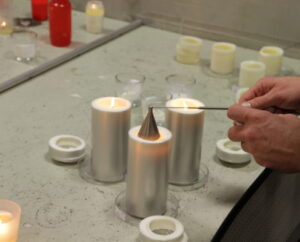
| On average, a maximum of 20 seconds | requirement met |
| On average, more than 20 seconds | requirement not met |
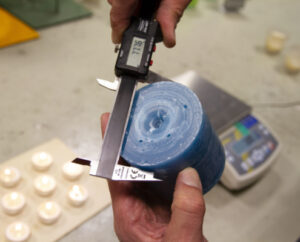
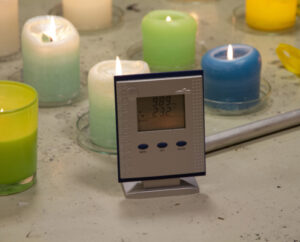
a) Dimensions:
| On average, conforms to dimensions | requirement met |
| On average, does not conform to dimensions | requirement not met |
Maximum permissible negative tolerance: 2%, but not less than 1 mm, applicable to diameter and length.
b) Burning time:
| On average, achieves burning time | requirement met |
| On average, does not achieve burning time | requirement not met |
If “approx.” or “±” is specified, a maximum negative tolerance of 10% is permissible.
Overall assessment of the candle is carried out on the basis of the inspection reports for internal and external quality assurance (assessment sheets), specified by the Quality Association for Candles.
The modalities for quality assurance and modification are set out in the General Quality Assurance and Test Specifications.
In the case of a positive overall assessment, the following quality mark is awarded with the addenda referred to in Section 7:
